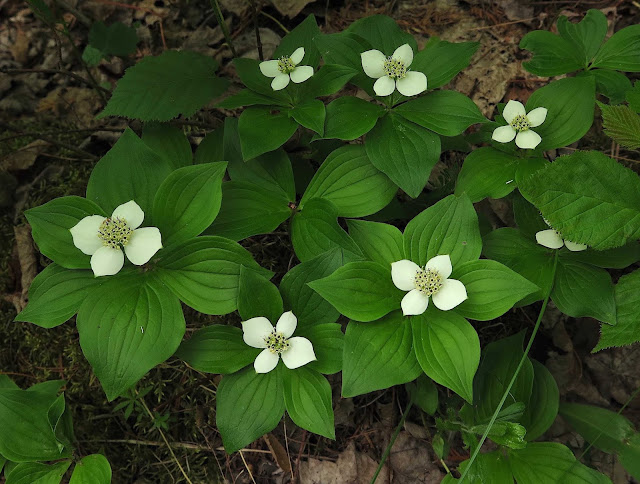I'm surrounded by so many botanical treasures here in northeastern New York, I can hardly keep up with them as they make their appearance! Just in the first three days of June I searched and found Wild Calla, Bog Laurel, Labrador Tea, Three-leaved False Solomon's Seal, and Virginia Chain Fern in a Warren County sphagnum bog; Glaucous Honeysuckle and Bunchberry blooming along a dusty Adirondack road in Essex County; and Green Dragon, Canada Onion and Deerberry blooms in a floodplain along the Hoosic River in Rensselaer County. I found many more plants, too, but these were the most photogenic!
A Warren County Sphagnum Bog
Wild Calla (Calla palustris) was blooming by the hundreds in this bog, with tiny flowers covering the chubby central green spadix. The snowy-white spathes and broad, green, heart-shaped leaves helped us locate them among all the other abundant greenery.
Bog Laurel (Kalmia polifolia) was almost past blooming in this bog, its fading flowers already yielding pretty red fruits. An immediately evident way to distinguish Bog Laurel from the similar-looking and habitat-sharing Sheep Laurel is that the flowers of Bog Laurel are borne in a terminal cluster, whereas the flowers of Sheep Laurel are surmounted by a terminal cluster of leaves. Also, Bog Laurel usually blooms a week or so earlier than Sheep Laurel. I'm glad I was able to witness at least one bloom on this quintessential bog shrub.
Labrador Tea (
Rhododendron groenlandicum) is a common denizen of sphagnum bogs, where the scent of its aromatic leaves signal its presence even before we notice its clusters of abundant white flowers. The orange-colored fuzz on the stems and underside of its leathery in-rolled leaves make its ID unmistakable.
Three-leaved False Solomon's Seal (Maianthemum trifolium) can be found only in acidic bogs, which helps us distinguish its 6-petaled, snowy-white, fragrant flowers from those of the related Maianthemum canadense, which grows in drier woodlands. Although the thousands of plants we found here were already producing their fruits, enough of the flowers remained to look as if someone had tossed handfuls of tiny stars across the moss.
Virginia Chain Fern (Anchistea virginica), with unfurling fronds. Although most ferns are notoriously difficult to identify at this stage, the fact that these fronds are strung out in a line and not emerging from a central cluster helped to suggest that identity immediately. The distinctive veining of the individual pinnae as well as the acidic habitat offered additional evidence. (Also, a friend who knows about these, told us that we would find them here!)

* * *
A Wilderness-Area Road in Essex County
Glaucous Honeysuckle (Lonicera dioica), a vining plant, is one of our few native honeysuckles. It is immediately recognizable by its showy terminal clusters of multi-colored flowers, which eventually produce equally showy clusters of red berries, centered within the terminal leaf-pair that is fused into one. I actually made the effort to visit this distant site so that I could lay my eyes on the beautiful Wild Purple Clematis that usually sprawls across the same marble boulders this honeysuckle vine does, and always this very week in June. But a late frost must have nipped off all the clematis flower buds this year, since not a single bloom or bud could I find among its trailing vine. Ah well, there's always next year! And the beauty of abundant Glaucous Honeysuckle flowers offered a kind of compensation.
Bunchberry (
Cornus canadensis). The snowy-white flowers of our tiniest dogwood also offered some solace to me, blooming in pretty patches along the same road where I'd hoped (and failed) to find that native clematis. As the summer proceeds, the tiny central flowers surrounded now by large white sepals will eventually produce the shiny-red berry clusters that suggested this plant's vernacular name.
* * *
Banks of the Hoosic River, Rensselaer County
Green Dragon (Arisaema dracontium) is related to our more familiar Jack-in-the-Pulpit and bears its odd flowers in a similar way, except that the Green Dragon's yellowish spadix is so long and narrow it can't be contained within its hooding spathe and "reaches for the sky!" And it is definitely not as widely common as J-Pulpits, at least in my experience, for this alluvial riverbank along the Hoosic River is the only place I have ever found them. And here they grow in abundant numbers as well as to prodigious size, attesting to the nutrient richness of the site.

Canada Onion (Allium canadense) is another plant that thrives in the rich, deep, alluvial soil along this stretch of the Hoosic River. Its slender stalks and grass-fine leaves are well hidden within the riverside greenery until it produces its signature tissue-covered clusters of bulblets that surmount each stem. And it doesn't stop there! For this wild onion doesn't take chances when it comes to reproduction, producing both sexual flowers as well as those clonal bulblets. Its small pink flowers are remarkably pretty!
Deerberry (Vaccinium stamineum) grows along the same banks of the Hoosic River, but higher up on the river's wooded shale cliffs instead of down on the low alluvial plain. This blueberry relative is easily distinguished from other members of its genus by the widely flaring, open flowers (white, but often speckled with tiny dark spots) from which protrude the long brownish stamens that undoubtedly suggested the shrub's scientific specific epithet. (I also see an even longer protruding pistil, but probably the taxonomist [most likely a male] who first named this flower chose to focus on the male parts. Typical!) The shrubs were particularly laden with abundant flowers this year. Too bad the fruits, while colored a lovely turquoise-blue dotted with white, are not at all palatable for humans. I wonder if the deer like them, hence the vernacular name.










No comments:
Post a Comment